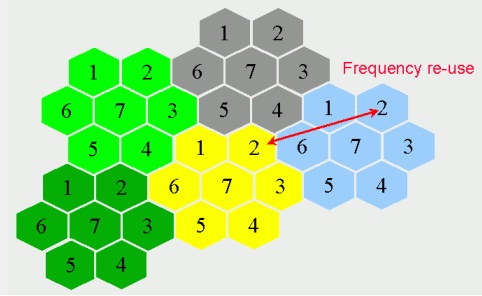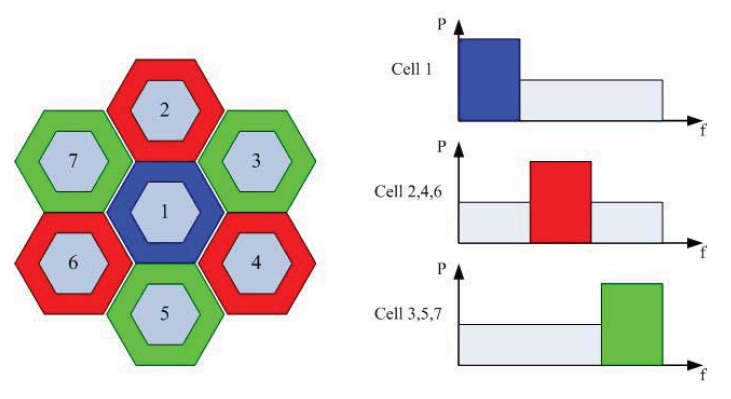Frequency Reuse is a well known concept that has been applied to wireless systems over the past two decades e.g. in GSM systems. As the name suggests Frequency Reuse implies using the same frequencies over different geographical areas. If we have a 25MHz band then we can have 125 GSM channels and 125*8=1000 time multiplexed users in a given geographical area. Now if we want to increase the number of users we would have to reuse the same frequency band in a geographically separated area. The technique usually adopted is to use a fraction of the total frequency band in each cell such that no two neighbor cells use the same frequency. Typically the frequency band is divided into 3 or 7 cells.

The division of the frequency band in to smaller chunks reduces the system capacity e.g. one cell with 25 MHz bandwidth would have much higher capacity then 7 cells having 3.5 MHz each. To overcome this problem a frequency reuse of 1 has been proposed i.e. each cell has the full system bandwidth (nearly). The problem of co-channel interference at the cell boundaries is resolved by dedicating a small chunk of the available spectrum for the cell edges.

In Soft Frequency Reuse (SFR) the cell area is divided into two regions; a central region where all of the frequency band is available and a cell edge area where only a small fraction of the spectrum is available. The spectrum dedicated for the cell edge may also be used in the central region if it is not being used at the cell edge. The lack of spectrum at the cell edge may result in much reduced Shannon Capacity for that region. This is overcome by allocating high power carriers to the users in this region thus improving the SINR and the Shannon Capacity.
Note:
1. The Signal to Interference and Noise Ratio is given as:
SINR=Signal Power/(Intercell Interference+Intracell Interference+AWGN Noise)
2. Typically the term capacity was used to describe the number of voice channels (or users) that a system can support. But with modern digital communication systems it usually refers to the Shannon Capacity that can be achieved (in bits/sec/Hz).
[1] Yiwei Yu, Eryk Dutkiewicz, Xiaojing Huang, Markus Mueck and Gengfa Fang, “Performance Analysis of Soft Frequency Reuse for Inter-cell Interference Coordination in LTE Networks”, ISCIT 2010.
Author: Yasir
More than 20 years of experience in various organizations in Pakistan, the USA, and Europe. Worked with the Mobile and Portable Radio Group (MPRG) of Virginia Tech and Qualcomm USA and was one of the first researchers to propose Space Time Block Codes for eight transmit antennas. Have publsihed a book “Recipes for Communication and Signal Processing” through Springer Nature.
42 thoughts on “Soft Frequency Reuse in LTE”
sir we used sub-band in pico cell but not in macro cell why?
Hi
good day
I read your article on the ASFR method. Very good and useful material. Thanks for your efforts, I have a request.
If possible, please submit the simulation code by MATLAB for the above article
Thanks
Will try to look into it. But generally I discuss principles not specific papers!
YA
hello sir,
can u tell me what is carrier frequency of lte system.how it is calculated.
I do not think I fully understand what you are asking but let me try to answer…frequency allocation is something which changes with region because the regulators look at the requirements of their own region…like FCC does the regulation in the USA…phones have the capability to work around the world so they support most of the frequencies that are allocated…please have a look at the following post
http://www.raymaps.com/index.php/lte-spectrum-allocation/
please also look a the following article from radio-electronics
http://www.radio-electronics.com/info/cellulartelecomms/lte-long-term-evolution/lte-frequency-spectrum.php
hello sir,
can u tell me what is carrier frequency of lte system.
Hello sir,i m not able to get full paper,only abstract part is getting displayed.can u guide me sir ,i need different frequency reuse schemes nd thier application.
thank you sir
hello sir can u explain me the differences between partial frequency reuse,soft frequency reuse and fractional frequency reuse schmes,with thier basic function
Have you looked at the following reference:
Yiwei Yu, Eryk Dutkiewicz, Xiaojing Huang, Markus Mueck and Gengfa Fang, “Performance Analysis of Soft Frequency Reuse for Inter-cell Interference Coordination in LTE Networks”, ISCIT 2010.
I m doing ME project,“Performance analysis of soft frequency reuse for LTE Advance system with carrier aggregation.can u help me with the codes for SFR and thesis report.
Thesis report and code must be your original work. You will not learn much by copy pasting. But if you have some specific questions maybe I can help.
hay i am working on soft frequency reuse in LTE, but i don’t know how to perform it in MATLAB
Bilal,
Before I can help you I need to know what do you want to simulate in SFR. Do you want to simulate the capacity achieved (could be voice channels, data rate in bps or spectral efficiency in bps/Hz), Bit Error Rate or something else.
I’m a student doing thesis in the Interferece In LTE. Please send me link to download it
hi
can anybody help me with hybrid Frequency reuse.and how to implement it in matlab
hi,
i would like to about hybrid Frequency reuse.
I am doing M.Tech project on soft frequency reuse in lte to increase performance of QoS parameters. So I am in need of sample codes on soft frequency reuse to simulate in matlab.Please kindly help.
DEAR ALL..
I’m a student doing thesis in the area of Soft Frequency Reuse. How can I obtain the simulator codes of the paper “Performance Analysis of Soft Frequency Reuse for Inter-cell Interference Coordination in LTE Networks” it is very important to me please if any one can help me with this.
Thanks in advance
If you can be more specific about the problem maybe someone here can help? Do share the paper that you have referred to…
John
Dear ALL,
I am currently doing my final year project on Dense Small cell networks at Makerere University with concentration on pico cells. However during my final year project proposal presentation, the following concerns were raised by the panel.
1) What are the key challenges being brought by small cells deployment in-terms of its high level of frequency reuse and it’s Spectral concerns.
2)How can its frequent hand over problems be mitigated.
3)What are the most likely challenges to arise in moving towards dense small network and how can it be mitigated.
please help me with some documents that will help me to solve those issues.
You can also send for me some of the sources where i can find it.
Thanks in advance
1. One problem that I foresee is that of co-channel interference but this can be mitigated by using directional antennas.
2. Frequent handovers can be avoided by having a super-cell for fast moving users and smaller cells (within super-cell) for stationary or slow moving users.
John
Hello, I’m doing B.Tech final year project on SFR in LTE ..
So I need MatLab codes..
I hope I will get.
Thanks in advance
hello John
I’m a student doing thesis in the area of Soft Frequency Reuse.
I really need to simlulate on matlab but I need the codes for SFR.
Thanks in advance
Hello,
I´m a student of Mexico and now, I’m doing my thesis about throughput for arrival rate, I am stuck in Simulation .
I need your help .Thanks
I am conducting my Final year B.Sc Thesis on Performance analysis of Softer Frequency Reuse in LTE network.
John , would you please help me going through it , I am stuck in Simulation . Your help would be pretty much needed.
Thanks in Advance.
Thanks John,
I need one more help i m doing project on “Dynamic Spectrum allocation in Femto based LTE network”. I have completed the implementing the same. But now i need to do some changes to that. What changes can be done..?
Pls help me its urgent
Hello brothers
I’m a student doing thesis in the area of Soft Frequency Reuse. How can I obtain the simulator codes of the paper “Performance Analysis of Soft Frequency Reuse for Inter-cell Interference Coordination in LTE Networks” it is very important to me please if any one can help me with this.
Thanks so much in advance
Hello brothers
I’m a student doing thesis in the area of Soft Frequency Reuse. How can I obtain the simulator codes of the paper “Performance Analysis of Soft Frequency Reuse for Inter-cell Interference Coordination in LTE Networks” it is very important to me please if any one can help me with this.
Thanks so much in advance
I am doing M.tech final year project on spectrum allocation inside femto cell. The IEEE paper which I have selected is Dynamic Spectrum Allocation in femto based LTE network. Can any one tell whether I need to concentrate on LTE or femtocell. I m very much confused.
Pls reply its very urgent
Anu,
I think you need to concentrate on Femto Cells. LTE Network is just one application of it.
John
Hello am doing a final year project on soft fractional frequency reuse in cognitive femto-cells in LTE. I really need to simlulate on matlab but I need the codes.
Thanks in advance
Does any body use LTE-Sim to simulate SFR or use matlab to simulate SFR ? what is the best way in terms of time and effort to simulate SFR ?
Hello brothers
I’m doing thesis and I really need a MATLAB codes for SFR.
Thanks so much in advance
What is the difference between FFR and SFR? I think they are almost the same.
How can I re-produce the SFR paper results based on the concept that you offered by using Matlab.
SFR as explained in [1].
“The soft frequency reuse (SFR) nowadays is considered as one of the most effective frequency planning strategies to mitigate inter-cell interference in cellular systems. It was first introduced in GSM, and then has been adopted under the 3GPP LTE framework with the aim of providing higher performance for users near the cell boundary. The basic idea of SFR is to apply a frequency reuse of one at the cell center area and a higher frequency reuse factor at the cell edge area. Rather than the hard frequency reuse (HFR, where reuse factor = 3) and fractional frequency reuse (FFR) schemes, SFR is able to reduce the inter-cell interference without largely sacrificing spectrum efficiency due to its lower reuse factor (nearly equal to one).
In SFR, the available spectrum is divided into two reserved parts: a cell-edge band and a cell-center band. Users within each cell are also divided into two groups, cell-center users and cell-edge users, based on their distance to the base station or other differentiating factors. Cell-edge users are restricted to the reserved cell-edge band while cell-center users have exclusive access to the cell-center band and can also have access to the cell-edge band but with lower priority.”
John: If you tell how can I upload the paper as a pdf file. it’ll be great
http://ieeexplore.ieee.org/xpl/freeabs_all.jsp?arnumber=5665044
this is the link for the paper of SFR mentioned above
Yaser: Please post a link to download the paper.
I’m a student doing thesis in the area of Soft Frequency Reuse. How can I obtain the simulator codes of the paper “Performance Analysis of Soft Frequency Reuse for Inter-cell Interference Coordination in LTE Networks” it is very important to me please if any one can help me with this.
Thanks in advance